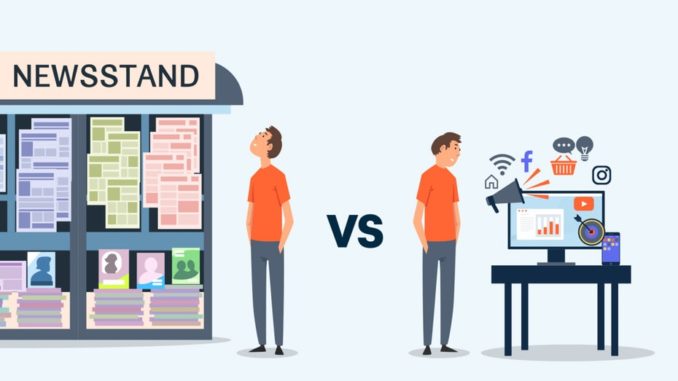
Digital marketing vs traditional marketing: what’s the difference between the two and which one should you use? Selecting the right marketing type is an age old question on every marketer’s mind. Here’s everything you need to know.
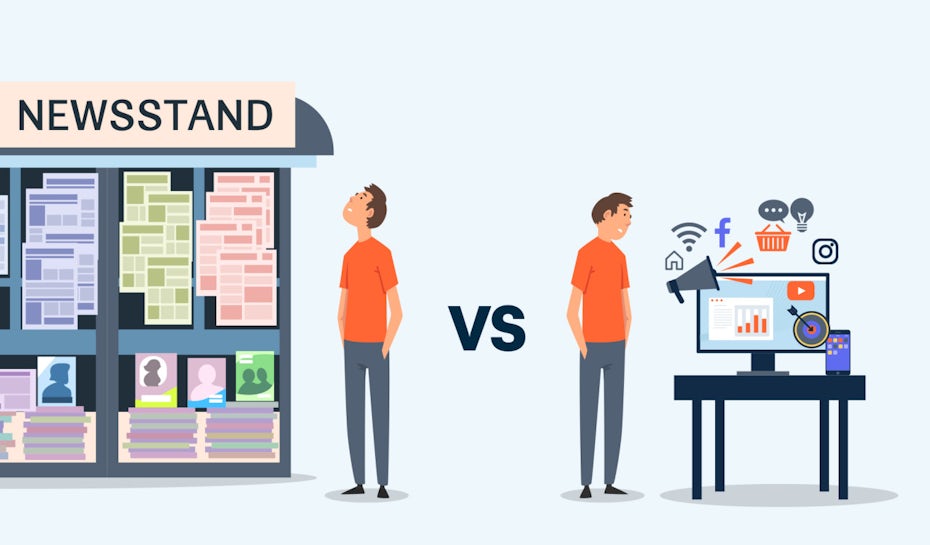
What is digital marketing?
—
Put simply, digital marketing is using digital channels such as websites and social media as tools for marketing communication.
If you’re using social media you will be well versed in the adverts that pop up in your stream—that’s digital marketing.
What is traditional marketing?
—
Traditional marketing on the other hand involves traditional channels, like billboards and printed media. Think Don Draper in Mad Men brainstorming TV commercial ideas and copy for Coca-Cola.
Up until the development of the internet in the 1990’s, traditional marketing was pretty much the only type of marketing.
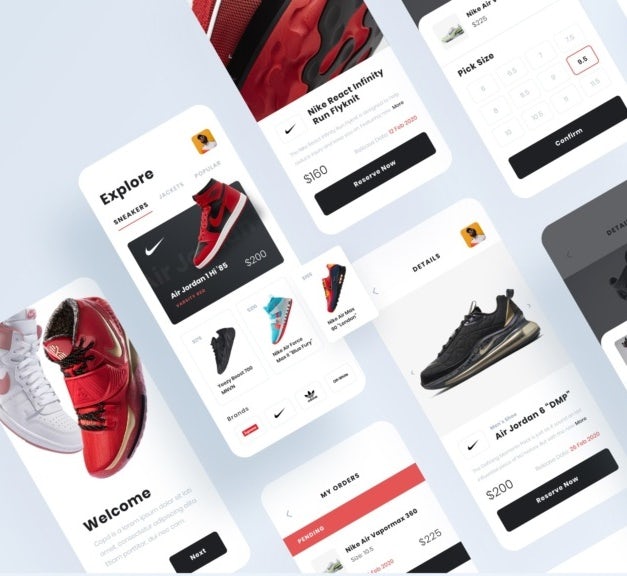

Digital marketing vs. traditional marketing: what’s the difference?
—
The main difference between digital and traditional marketing is the medium through which an audience encounters a marketing message. While traditional marketing uses traditional media like magazines and newspapers, digital marketing uses digital media, such as social media or websites.

Of course traditional marketing doesn’t mean it’s old fashioned. Traditional marketing still plays an important role in people’s lives with the ever growing need to step out of the digital world.
The immersive experience of an impactful TV commercial and the tactile nature of a copy of Rolling Stone magazine are as important today as they were 20 years ago because of their lasting effects on your memory. Subconsciously you attach yourself to their brand emotionally, meaning they will stay at the top of your mind.
In the same token, digital marketing is just as important as traditional if not even more so. Digital marketing uses every touch point of your daily use of the internet to reach you.

If you are google searching holiday ideas for your next weekend getaway, the chances are that soon after you will see a tailored sponsored ad from Sky Scanner.
Using the internet for several hours each day is a normal part of most people’s day to day life. Digital marketing just uses this to its advantage by cleverly weaving in marketing communications into every digital channel.
Which type of marketing should you use?
—
The key to a great marketing campaign is to find the right balance between traditional and digital. In 2020, digital marketing is the yin to traditional marketing’s yang. Both play an important role in a marketing strategy, but they are each elevated when used in unison.
Take Guinness for example. Their TV commercials are infamous because of their unique and powerful cinematography. Over 20 years later, Guinness’ classic 1999 ‘Surfer’ campaign is still one of the best TV commercials of all time. However, even with this legendary status, Guinness still have to move with the times and incorporate digital marketing into their strategy so that they don’t miss out on some huge marketing opportunities.
Via Guiness
In order to reach a broader and younger audience, Guinness recently expanded their digital marketing horizons by making video content specifically for Facebook and Instagram. Rather than just reformatting their TV commercials, they filmed their campaigns as social first videos by composing the shots specifically with both Facebook and Instagram in mind. The videos were specifically targeted to the audiences they had in mind.
The result was a visually stunning and impactful social media campaign about Compton cowboys caring for their horses in California. Perfectly trendy and sharable Instagram fodder.

Let’s get to the specifics and define the differences between digital marketing and traditional marketing and their pros and cons.
Traditional marketing: pros and cons
—
With the rise of social media, traditional marketing is often undervalued by marketers. However, traditional marketing still very much has a place in a consumer’s day to day life. If you have the budget to share your campaigns in magazines and prime time TV, your money could be well spent.

Traditional marketing channels include:
- Outdoor (Billboards, bus/taxi wraps, posters etc)
- Broadcasting (TV, Radio etc)
- Print (Magazines, newspapers etc)
- Direct Mail (catalogues etc)
- Telemarketing (Phone, text message)
- Window display and signs
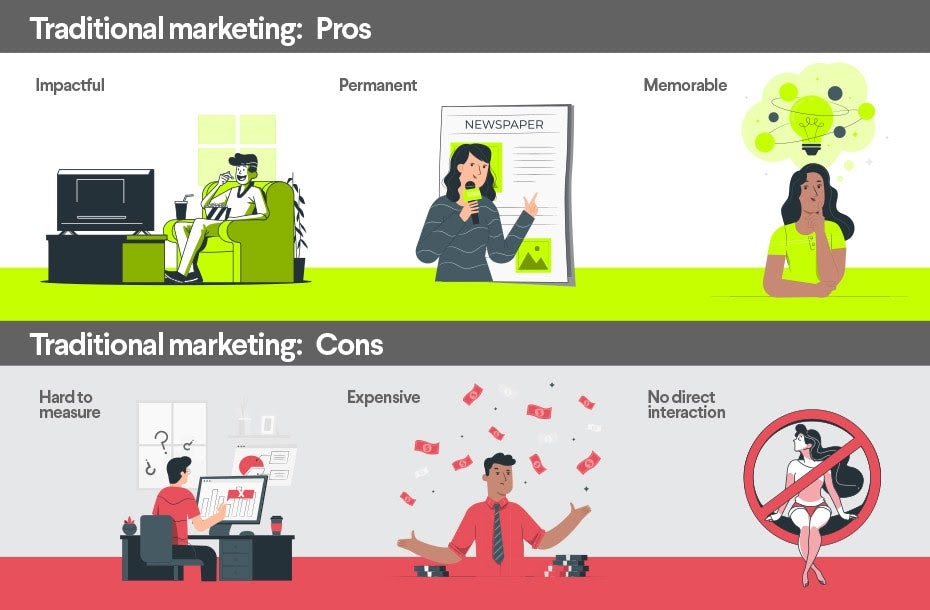
Pros:
Impactful and easy to understand
A visually bold billboard or a striking TV commercial is a normal part of most people’s day to day lives. They’re easy to digest and often entertaining.
Printed marketing materials are more permanent
If you have an advert in an issue of The New York Times it will be there until the magazine is recycled. Which is great if the consumer is an avid collector.
Seeing something in real life rather than on your phone is more likely to be remembered. The anticipation of the new Super-Bowl ads or a beautiful and impressive window display is more likely to stay in your mind than an instagram ad you’ll probably scroll past in seconds.
Cons:
There are ways to measure traditional marketing campaigns such as brand trackers but they are nowhere near as in depth or intelligent as the tools available for digital marketing.
Often expensive
If you’re a brand in its infancy chances are you don’t have the funds for a 4 page spread in Vogue. Many forms of traditional marketing will set you back a considerable amount.
No direct interaction with the consumer
Unlike social media marketing, you’re more or less in the dark about your audience’s reaction to your marketing efforts.
Digital marketing: pros and cons
—
However impactful traditional marketing is, we can’t forget that we are well and truly living in the internet age.
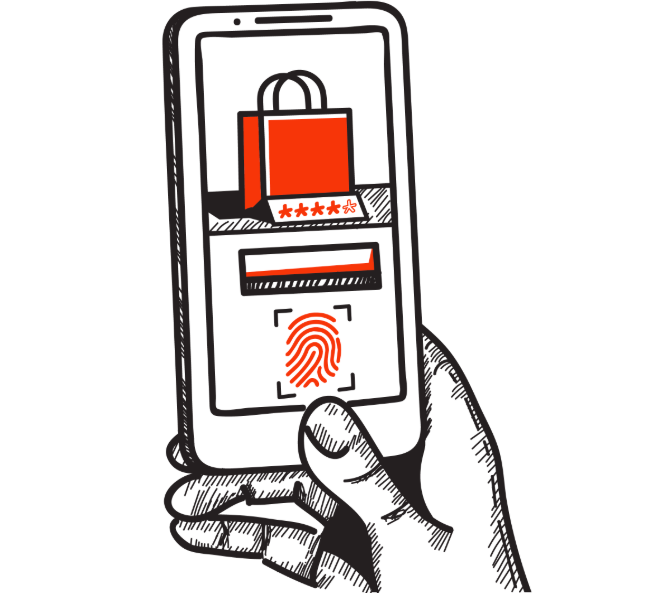
According to ClickZ, “Internet users now make up 57% of the global population. On average, people spend 6 hours and 42 minutes online each day. By 2021, a projected 73% of all ecommerce sales will come from mobile.”
That’s a mind-bogglingly huge amount of time and opportunity to do some clever digital marketing.
Digital marketing channels include:
- Social media (Facebook, Instagram etc)
- Website
- Content marketing
- Affiliate marketing
- Inbound marketing
- Email marketing
- PPC (pay per click
- SEM (Search engine marketing)
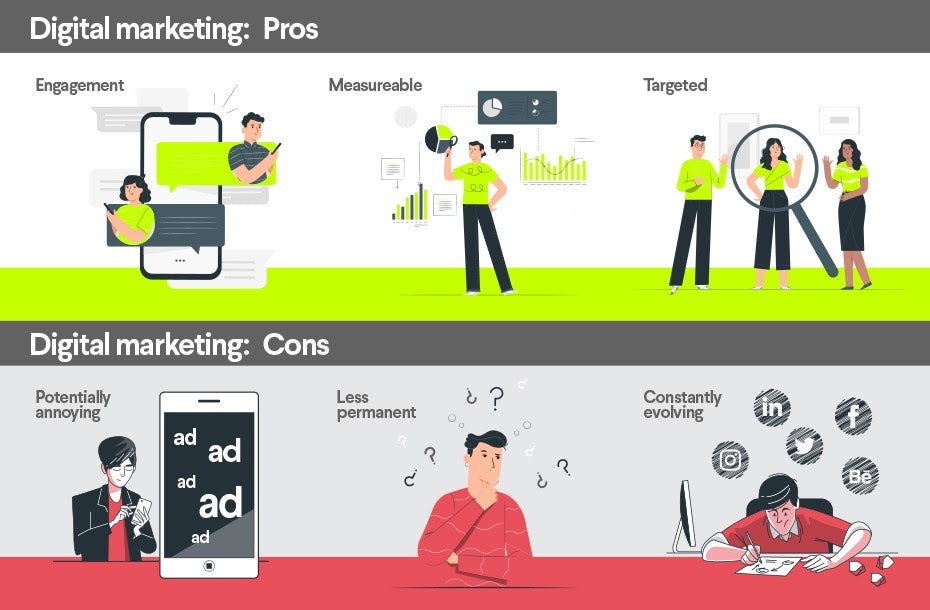
Pros:
Through channels such as social media you can physically see what your audience think of your brand and marketing efforts. If your marketing has been shared, liked and had plenty of positive comments, you know you’re doing something right.
Easy to measure your campaigns
On the flipside to traditional marketing, the specifics of digital marketing tracking is exceptionally in depth. This makes your learnings extremely clear for your next round of marketing efforts.
Makes clever targeting possible
If you have the tools to specifically target a 29 year old female writer who loves Lizzo and drinking Guinness then surely you can also create perfectly tailored content?
Cons:
Digital ads can be deemed as annoying
Think about the moment you’re scrolling through your Facebook homepage and all you want to do is see what your old school friends are up to these days. Then you get the dreaded sponsored ad for something related to an embarrassing ailment you googled the night before. It’s sure to make you actively dislike the very brand doing the clever targeting.
Less permanent
Digital marketing efforts like Google ads, banners, promo emails or social media ads can have a fleeting, temporary character. They’re intangible and can easily be ignored. If your target audience keeps scrolling or clicks to the next page your ad will be gone from their screen.
Constantly evolves
To get the most out of your digital marketing efforts there is a lot to learn. Each channel usually requires its own specialist, from search engine marketing to social media, each channel requires a pro to get the best bang for your buck. However, a grass-roots social media marketing strategy is a great place to start. Have a look at our digital marketing strategy guide for some inspiration.
Find what works for you
—
Ultimately both types of marketing have their benefits and downfalls, but the key is understanding your specific marketing needs, considering your budget and understanding your target audience.
Traditional marketing channels are often more expected and welcomed by the Baby Boomer generation and Gen X—people who own televisions and prefer to buy newspapers for example. However, digital marketing is a surprisingly suitable route for all ages, not just millennials and Gen Z—my nan spends hours scrolling through Facebook, sharing Lad Bible videos and shopping online.
The moral of the story: both digital and traditional marketing can work for you, as long as you know what your audience wants.
Need outstanding marketing materials designed?
Our designers can help you create just about anything.
The post Digital marketing vs. traditional marketing: what’s the difference? appeared first on .
